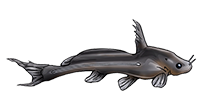Ankita, A., Khan, M., & Khan, S. (2023). Edad y crecimiento del pez casi amenazado Rita rita (Siluriformes: Bagridae) en la cuenca del Ganges. Revista de Biología Tropical, 71(1).
https://www.scielo.sa.cr/scielo.php?pid ... ct&tlng=es
Key words: vertebrae; otoliths; ageing precision; VBGF; Marginal Increment Analysis.ABSTRACT
Introduction: is a freshwater catfish under threat of extinction, mainly from loss of breeding and nursing grounds. A reliable method for age and growth estimation is needed by fishery managers.
Objective: To identify the best body structure for age and growth estimation.
Methods: We assessed estimates precision based on Average Percent Error (APE), Coefficient Variation (CV), and Percent Agreement (PA) between readers separately analyzed each calcified structure. We used 390 fish samples from three rivers, Ganga, Yamuna and Ramganga, from September 2018 to August 2019.
Results: The three indicators favored the use of vertebrae for age estimation; the growth band seems to be annual and formed from May to September. The growth equations were Lt = 90.19(1-e-0.145(t+0.51)) for Ganga; Lt = 91.19 (1-e-0.14(t+0.59)) for Yamuna and Lt = 89.63 (1-e-0.15(t+0.68)) for Ramganga.
Conclusion: This species reaches moderate growth in these rivers, where vertebrae are the recommended age estimation structure, followed, in case of need, by sectioned otoliths, whole otoliths and opercular bones. Pectoral spines should be avoided, especially in older fish.
Palabras clave: vértebras; otolitos; precisión de la edad; VBGF; Análisis del Incremento Marginal.RESUMEN
Introducción: Rita rita es un pez de agua dulce bajo amenaza de extinción, principalmente por la pérdida de sitios de reproducción y crianza. Un método fiable para las estimaciones de edad y crecimiento es necesario para los administradores de recursos pesqueros.
Objetivo: Identificar la mejor estructura corporal para estimaciones de edad y crecimiento.
Métodos: Evaluamos la precisión de las estimaciones mediante el Porcentaje de Error Promedio (APE), Coeficiente de Variación (CV), y Porcentaje de Acuerdo (PA) entre lecturas para cada estructura calcificada. Usamos 390 muestras de peces de tres ríos, Ganga, Yamuna y Ramganga, de setiembre 2018 hasta agosto 2019.
Resultados: Los tres indicadores favorecieron el uso de vértebras para la estimación de edad; la banda de crecimiento parece ser anual y se forma entre mayo y setiembre. Las ecuaciones de crecimiento fueron Lt = 90.19(1-e-0.145(t+0.51)) para Ganga; Lt = 91.19 (1-e-0.14(t+0.59)) para Yamuna y Lt = 89.63 (1-e-0.15(t+0.68)) para Ramganga.
Conclusión: La especie alcanza un crecimiento moderado en estos ríos, dónde las vértebras son la estructura de estimación etaria recomendada, seguido de, en caso de ser necesario, los otolitos segmentados, otolitos enteros y huesos operculares. Debe evitarse el uso de espinas pectorales, especialmente en peces de mayor edad.





